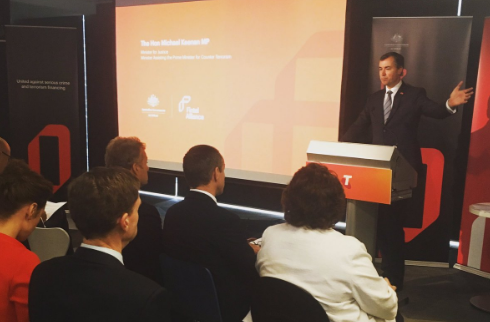
Justice Minister Michael Keenan recently launched the Fintel Alliance, a public-private partnership combating money laundering and terrorism financing. The partnership is unique internationally, bringing together 19 public and private sector organisations to counter these dual threats.
Led by the financial intelligence agency, AUSTRAC, the alliance members include law enforcement and intelligence agencies, the Tax Office, and private sector companies including the big four banks and Macquarie Bank, Western Union and PayPal. The initiative responds to a significant weakness in Australia’s ability to fight financial crime and terrorism financing, underdeveloped processes to share information between the public and private sectors.
So how does it work? Co-located in an Operations Hub (PDF), intelligence analysts from alliance partners collaborate on projects, combining information, knowledge and perspectives on an issue. To begin with, the alliance will examine information from the Panama Papers (PDF) exploitation of Australian Cyber Online Reporting Network (PDF) data, and identification of money mules (PDF).
Multi-agency task forces to fight specific crimes have been very effective. Project Wickenby—a taskforce focused on international tax evasion ran from 2006 until mid-2015—resulting in 46 convictions and recovering $986 million in unpaid tax. Wickenby’s success was continued by the Serious Financial Crime Taskforce (beginning on 1 July 2015) which has already obtained 5 convictions and recouped nearly $100 million. Previously these task forces have been limited to government agency participation, with the private sector excluded. Bringing in the private sector under the same roof makes the Fintel Alliance unique in this area.
Private sector involvement’s critical because money is laundered, terrorist funds are raised and illicit money is moved through private sector service providers—including banks, money remitters, casinos and other gambling businesses.
That’s why many companies are obliged by law to adopt mitigation strategies to prevent their services being used for nefarious purposes. It’s also why private sector companies must provide reports on certain transactions and suspicious matters to AUSTRAC. This information has enormous intelligence value (PDF) for law enforcement.
Companies need information from government to help them identify suspicious matters and mitigate risks. To date government has provided some information but it’s been too limited and untimely. The alliance should greatly improve this flow.
Collating more information from a wider range of sources will build a more complete picture. Better information allows for better targeted monitoring and investigations, saving time, reducing unnecessary work, and boosting business and law enforcement productivity. And the sharing of information in near real time will significantly speed up processes.
But the alliance is about more than just intelligence. Government and private sector partners also collaborate in the Innovation Hub which allows partners to develop innovative solutions to mutual problems. For example, the rules do not need to be one-size-fits-all and can be tailored to counter the specific risks of particular services. So new rules responding to financial sector innovation can be designed with early input from those effected. And controls can be built into new services and systems. This will reduce regulatory cost to business. Technological innovation in customer identification and automated detection tools can also be explored. Developments can benefit all of industry, not just those involved in the partnership.
So the alliance offers great promise. But what opportunities should its stakeholders look for, and what will success look like over the coming years?
First, the alliance should focus on successful investigations leading to prosecutions and financial recovery in the three target areas: the Panama Papers, cybercrime, and money mules.
Second, creating a trusted system with a sense of common purpose will be important. As David Connery, then of ASPI, noted, this is key to optimal information sharing. Such a system will form the basis of successful public-private sector cooperation into the future.
Third, there is the opportunity to develop the skills and knowledge of financial intelligence analysts. This should happen organically when analysts from different agencies and companies work closely together in the Operations Hub. It will also be well supplemented by the new Financial Intelligence Analysts’ Course (PDF). Greater knowledge and tradecraft skills will improve analysts’ ability to detect financial crime and terrorism financing. There is also the opportunity to co-develop typologies and case studies to better understand criminal and terrorist methods. Sanitised versions could be released publicly for the benefit of all.
Opportunities exist for intelligence analysts to move from the private sector to government and vice versa, either permanently or by secondment.
Once operating successfully, Fintel Alliance should look to expand involvement to other domestic companies and industries and international partners, adding to the current UK National Crime Agency participation.
Integration and better exploitation of data held by partner organisations presents great opportunity, especially with advancements in big data analytics.
The government’s to be applauded for an innovative solution to enhancing information sharing in the fight against crime and terrorism. There’s still much to be done.